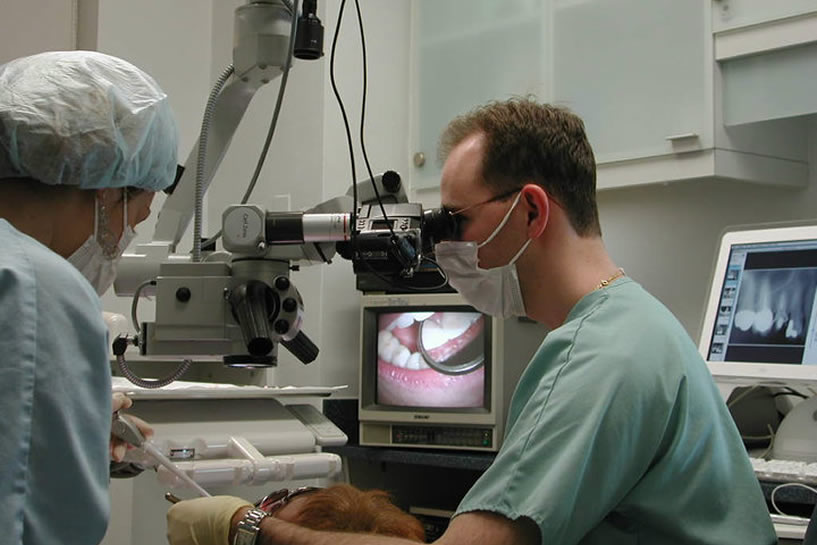In the bustling heart of Manhattan, where dental care is paramount, patients often encounter terms like root canal retreatment and root canal revision. These terms can be confusing, but understanding them is crucial for making informed decisions about your dental health. At Fifth Avenue Endodontics, under the expert care of Dr. Iofin, we aim to demystify these endodontic treatments for our patients.
Root canal retreatment and root canal revision, while related, address different aspects of dental care. Retreatment focuses on correcting issues within the canal system itself, such as persistent infection or incomplete initial treatment. Revision, on the other hand, deals with structural problems of the tooth or restoration, such as fractures or poorly fitting crowns.
Both procedures play essential roles in maintaining dental health, but they require different approaches and techniques. At Fifth Avenue Endodontics, we understand the nuances of these treatments and tailor our approach to each patient’s unique needs. Our goal is to provide clear information so you can understand the specific reasons for each procedure and make the best choices for your oral health.
This article will clarify the distinction between root canal retreatment and root canal revision, explaining when each procedure is necessary and how they differ in terms of approach and goal. By understanding these differences, you can better navigate your dental care options and achieve optimal oral health.
Understanding Root Canal Retreatment
Root canal retreatment is a procedure performed when a previously treated root canal fails to heal or develops new issues. This can happen due to various reasons, including complex canal anatomy that was not fully addressed during the initial treatment, new decay that exposes the root canal to infection, or a loose or cracked restoration allowing bacteria to re-enter the canal system. Often, the initial treatment may not have adequately cleaned and sealed all of the intricate pathways within the tooth, leading to persistent or recurrent infection.
In some cases, new issues can arise even after successful initial treatment. For instance, over time, the seal placed during the original procedure might deteriorate, or a new cavity might form, compromising the tooth’s integrity. Additionally, if a crown or filling placed on the treated tooth becomes loose, cracked, or damaged, it can create a pathway for bacteria to enter the root canal system, necessitating retreatment.
Root canal retreatment involves removing the old filling material from the tooth’s canal, thoroughly cleaning and disinfecting the canal space, and then refilling and sealing it. This process ensures that any remaining infection is eradicated and that the canals are properly sealed to prevent future issues. Under the expert care of Dr. Iofin at Fifth Avenue Endodontic, patients can trust that their retreatment will be performed with the highest level of precision and care, addressing all underlying issues to promote healing and restore dental health.
When is Root Canal Retreatment Necessary?
Root canal retreatment becomes necessary when patients experience persistent symptoms such as pain, swelling, or infection months or even years after the original root canal treatment. Despite the initial treatment’s success, some teeth may not heal as expected or may develop new issues over time. This can occur due to various reasons, including:
- Incomplete Canal Cleaning: During the initial root canal treatment, intricate canal anatomy may not have been fully addressed or accessed. This can leave behind areas where bacteria can persist, leading to infection.
- New Decay: Teeth treated with root canals are not immune to new decay. If decay develops around the restoration or beneath it, it can expose the root canal system to bacteria, causing infection.
- Faulty Restoration: A loose, cracked, or damaged filling or crown can compromise the seal created during the initial root canal procedure. This allows bacteria to re-enter the canal space and cause reinfection.
The Retreatment Procedure
When retreatment is deemed necessary, Dr. Iofin and his experienced team at Fifth Avenue Endodontics undertake a meticulous process to ensure the tooth’s health and longevity:
- Access and Removal: The first step involves carefully accessing the tooth’s interior by removing the existing restoration and any filling materials used during the initial treatment.
- Cleaning and Disinfection: Once the canal system is exposed, special instruments are used to clean out any remaining infected tissue and disinfect the canals thoroughly. This step is crucial to eliminating bacteria that may have caused reinfection.
- Refilling and Sealing: After cleaning, the canals are filled with a biocompatible material to seal them effectively and prevent future infection. A temporary filling is usually placed to protect the tooth while a new permanent restoration, such as a crown, is prepared.
Advanced Techniques at Fifth Avenue Endodontics
At Fifth Avenue Endodontics, Dr. Iofin utilizes advanced endodontic techniques and state-of-the-art technology to ensure the success of root canal retreatment. Digital imaging helps in accurately diagnosing the need for retreatment and planning the procedure with precision. Ultrasonic instruments are employed to effectively clean and shape complex canal systems, ensuring thorough disinfection and optimal sealing.
Patient-Centered Care
Throughout the retreatment process, patient comfort and understanding are prioritized at Fifth Avenue Endodontics. Dr. Iofin and his team take the time to explain each step of the procedure, addressing any concerns or questions patients may have. By providing clear information and personalized care, they aim to restore not just the tooth but also the patient’s confidence in their dental health.
Manhattan Root canal retreatment at Fifth Avenue Endodontics is a specialized procedure designed to address persistent or recurring issues following initial root canal treatment. By understanding the reasons behind retreatment and the meticulous approach taken by Dr. Iofin and his team, patients can feel confident in their decision to preserve their natural teeth and maintain optimal oral health. If you are experiencing symptoms that may indicate the need for root canal retreatment, don’t hesitate to schedule a consultation with Fifth Avenue Endodontics for expert evaluation and care.
Exploring Root Canal Revision
Root canal revision is a specialized procedure aimed at addressing complications that arise from the structural aspects of the tooth or its restoration, rather than focusing solely on the internal canal system. Unlike root canal retreatment, which primarily deals with issues within the root canals themselves, revision tackles broader challenges that affect the tooth’s overall stability and function.
When is Root Canal Revision Necessary?
Root canal revision becomes necessary when structural issues compromise the effectiveness of the initial root canal treatment. Common reasons for revision include:
- Fractured Roots: If a tooth develops cracks or fractures that extend into the root structure, it can jeopardize the integrity of the root canal treatment. Revision may involve stabilizing the tooth or, in severe cases, considering extraction and replacement options.
- Problematic Restorations: A poorly fitting crown or filling can create gaps or spaces where bacteria can accumulate, leading to infection or decay. Revision may involve removing and replacing the restoration to ensure it properly seals the tooth and supports the root canal treatment.
- Repairing Outer Structure: Sometimes, the outer structure of the tooth may deteriorate due to trauma, extensive decay, or previous dental work. Revision procedures may include repairing or rebuilding the tooth’s outer layers to provide adequate support for the root canal treatment.

The Revision Process
Root canal revision is a meticulous process that begins with a thorough evaluation of the tooth’s condition and the effectiveness of the previous root canal treatment. Dr. Iofin and his team at Fifth Avenue Endodontics employ advanced diagnostic tools and imaging techniques to assess the extent of any structural damage and plan the appropriate course of action.
Depending on the specific issues identified, the revision process may involve:
- Removing and replacing faulty restorations: This ensures a proper seal and prevents further damage or infection.
- Reinforcing fractured roots: Techniques such as root canal surgery or placing supportive materials may be used to stabilize the tooth and preserve its function.
- Rebuilding tooth structure: In cases of significant damage, techniques such as dental crowns or onlays may be employed to restore the tooth’s structural integrity and support the existing root canal treatment.
Expert Care at Fifth Avenue Endodontics
At Fifth Avenue Endodontics, Dr. Iofin brings decades of experience and expertise to each root canal revision procedure. Utilizing state-of-the-art technology and advanced techniques, he ensures that each patient receives personalized care tailored to their unique dental needs. By addressing both the internal and external factors affecting the tooth’s health, Dr. Iofin aims to achieve optimal outcomes that restore function, comfort, and confidence in patients’ smiles.
Understanding the role of root canal revision in preserving dental health is essential for making informed decisions about your oral care. By addressing structural complications that affect the effectiveness of root canal treatment, revision procedures at Fifth Avenue Endodontic offer patients a pathway to maintaining natural teeth and long-term oral health. If you suspect you may benefit from root canal revision or have concerns about a previous root canal treatment, schedule a consultation with Dr. Iofin for expert evaluation and personalized care.
Key Differences Between Retreatment and Revision
Approach and Goal
The primary difference between retreatment and revision lies in their approach and goal. Root canal retreatment focuses on addressing issues within the canal system itself, aiming to eradicate infection and ensure the canals are properly sealed. The goal is to save the tooth by redoing the internal treatment and promoting healing from within.
Root canal revision, however, addresses external structural issues of the tooth or the restoration that compromise the effectiveness of the root canal treatment. The goal of revision is to repair or replace the outer structure to support the treated canal system adequately.
Tools and Techniques
Retreatment often involves the use of specialized endodontic tools to navigate and clean the intricate canal system. Techniques such as ultrasonic cleaning and the use of advanced disinfectants are crucial for successful retreatment. Revision may involve different dental tools and materials tailored to repairing or replacing structural components, such as crowns or fillings.
Prognosis and Outcomes
Both procedures aim to save the natural tooth and restore function and aesthetics. However, the prognosis can vary based on the specific issues being addressed. Root canal retreatment typically has a high success rate, especially when performed by experienced endodontists like Dr. Iofin at Fifth Avenue Endodontics. Root canal revision outcomes depend on the extent of structural damage and the effectiveness of the new restoration.
Choosing the Right Treatment: Consultation and Diagnosis
Determining whether you need root canal retreatment or root canal revision requires a thorough consultation and diagnosis. At Fifth Avenue Endodontic, Dr. Iofin utilizes state-of-the-art diagnostic tools, including digital radiography and 3D imaging, to assess the condition of your tooth accurately. This comprehensive evaluation helps in formulating a precise treatment plan tailored to your specific needs.
Signs You Might Need Retreatment
- Persistent pain or discomfort after initial root canal treatment
- Swelling or infection around the treated tooth
- Visible damage to the original filling or crown
- Detection of new decay near the treated tooth
Signs You Might Need Revision
- Cracked or fractured tooth structure
- Loose or damaged restoration
- Significant decay compromising the tooth’s integrity
- Bite issues caused by improperly fitting restorations

Conclusion
Understanding the difference between Manhattan root canal retreatment and root canal revision is essential for making informed decisions about your dental health. At Fifth Avenue Endodontics, Dr. Iofin and his team are dedicated to providing the highest standard of care, whether you require retreatment to address internal canal issues or revision to repair structural problems. By addressing these concerns promptly and effectively, we strive to preserve your natural teeth and maintain your oral health for years to come.
If you suspect you might need root canal retreatment or root canal revision, don’t hesitate to schedule a consultation with Dr. Iofin at Fifth Avenue Endodontic. With expert care and advanced technology, we are here to help you achieve optimal dental health.

